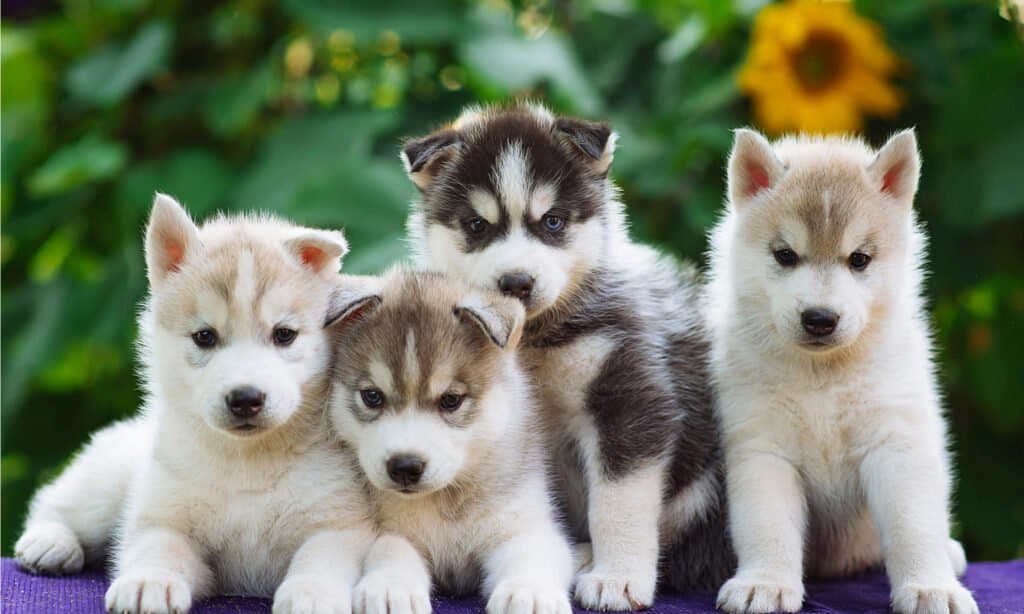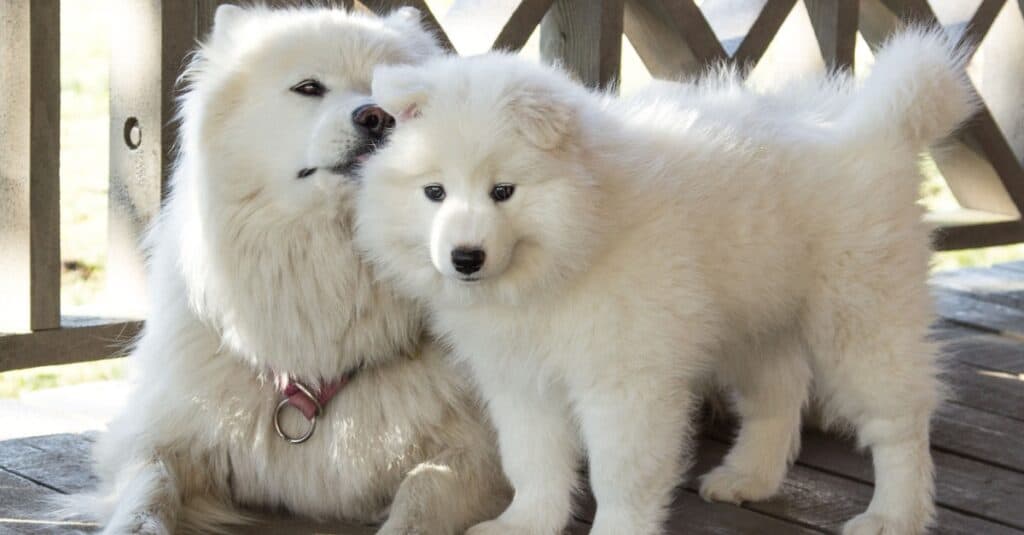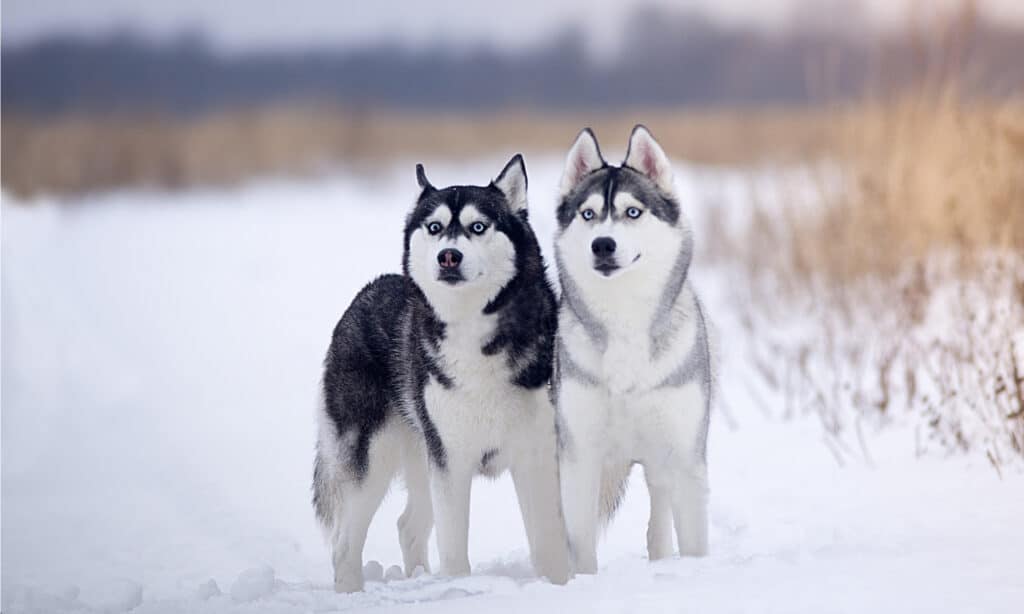Samoyeds and Siberian Huskies are similar dogs, both bred for cold environments with fluffy double coats. These dogs are family-loving, active, and friendly. Samoyeds are long-haired, fluffy dogs that are people-pleasing and easy to train with a tendency to guard. Huskies tend to love everyone and don’t make good guard dogs. They also have an independent streak and want to make their own decisions!
In this article, we’ll talk about the differences between these two fluffy, adorable breeds.
Comparing Samoyed vs Siberian Husky

| Samoyed | Siberian Husky | |
|---|---|---|
| Size | 19-23.5 inches, 35-65 pounds | 20-24 inches, 35-60 pounds |
| Appearance | “Smiling” mouth, dark eyes, curled tail | Blue and multi-colored eyes are common |
| Temperament | Protective | Friendly |
| Training | Easy | Intermediate |
| Energy | High-energy | Extremely high-energy |
| Coat | Long double coat in the colors white, biscuit, and cream | Medium-length double coat in the colors black, white, and white with agouti, black, black and tan, brown, grey, red, or sable |
| Grooming | Daily brushing | Weekly brushing. Rake out their fur regularly during the shedding season |
| Shedding | Average | High |
| Dog Tolerance | Might be dog-selective or stand-offish around strange dogs | Incredibly friendly toward other dogs |
9 Key Differences Between Samoyed and Siberian Husky
There are some key differences between Samoyeds and Siberian Huskies. These include size, appearance, coat length, coat color, guarding behavior, trainability, energy level, grooming needs, shedding, and dog tolerance.
The biggest difference between a Samoyed and a Siberian Husky is their appearance and coat. Samoyeds tend to be light in color with dark eyes, a mouth that curls into a “smile,” a curled tail, and long fur.
Meanwhile, Huskies are born in a wide range of colors and commonly have blue or multi-colored eyes and medium-length fur.
We’ll dive into all of these in detail below!
Samoyed vs Siberian Husky: Size

Samoyeds are slightly larger than Huskies.
©Ilya Barmin/Shutterstock.com
There is little difference between these dogs in size, but Samoyeds can grow slightly larger, weighing up to 65 pounds compared to a Huskies’ maximum of 60 pounds. Samoyeds can also be slightly shorter at 19 inches tall, while Huskies stand no less than 20 inches.
Samoyed vs Siberian Husky: Appearance

Huskies are born in a wide variety of colors.
©mary.foto.great/Shutterstock.com
While these dogs have similar body shapes and sizes, they’re quite different in appearance. It’s easy to tell them apart with a quick glance. First, look at the eyes. Samoyeds tend to have dark brown eyes, while Huskies often have blue or multi-colored eyes. However, their eyes can also be brown.
Next, Samoyeds have a characteristic “smile” or upward tilt of their mouths. This cute trait makes them look jolly all of the time!
Lastly, a Samoyed’s tail will curl upward toward its back.
Samoyed vs Siberian Husky: Coat
Of course, their coats are also different—so much so that we gave them their own special category!
Samoyeds are light in color. They can be white, cream, biscuit, or white and biscuit according to breed standard. No markings are allowed in purebred show dogs. Their fur is long, fluffy, and double-coated.
Siberian Huskies come in more of a variety, with breed standards specifying these colors:
- Agouti and white
- Black
- Black and white
- Red and white
- Brown and white
- Grey and white
- Black, tan, and white
- Sable and white
- White
Huskies can have saddle-back markings as well. Their fur is medium-length and double-coated.
Samoyed vs Siberian Husky: Grooming

Samoyeds are high-maintenance when it comes to grooming.
©iStock.com/Irina Tetereva
The Samoyed’s long fur requires daily brushing, or else it will mat. Combing may be necessary if the fur begins to tangle, and it takes time and dedication to keep its fur maintained. More time is required during the shedding season once or twice yearly.
Huskies, like most dogs, should be brushed once a week. This distributes their natural oils throughout their coat, making it appear sleek and healthy.
Siberian Huskies also have a shedding season one to two times yearly in which they’ll need their undercoat raked out daily.
Samoyed vs Siberian Husky: Shedding
Samoyeds shed a moderate amount, but it seems like a lot due to the thickness and length of their coat. Their large size also means plenty of shed hair on your furniture, carpeting, and clothes!
Siberian Huskies are heavy shedders. Weekly brushing can help reduce shed fur, but you should still expect to drag out the vacuum regularly and keep a lint roller on hand.
Samoyed vs Siberian Husky: Temperament

Huskies tend to think everyone is their friend!
©SaKuramaS/Shutterstock.com
The biggest difference in temperament is the tendency to guard. Samoyeds make great watch and guard dogs, alerting you to intruders. They’re incredibly loyal and sometimes clingy to their human families.
Siberian Huskies, on the other hand, think of just about everyone as a friend! They’re more likely to drown a burglar in kisses than anything. They also have an independent streak and like to think for themselves, though they can also cling to family and don’t like spending long periods alone.
Both are good sets of traits—it just depends on what you personally want in a pup.
Samoyed vs Siberian Husky: Training
Samoyeds were bred as companions, so they’re pretty eager to please. They are loyal and want you to be happy with them! You’ll often find your Samoyed looking to you for approval.
Huskies find their own approval more important. They have a stubborn, independent streak that can be tough to break. This is why you see so many Husky temper tantrums online!
It’s important to train them using positive reinforcement, keeping sessions fun and short so that they’re eager to engage.
Samoyed vs Siberian Husky: Energy
Both breeds are high-energy, but Huskies have Samoyeds beat. They’re working dogs, bred for endurance and always ready to go!
They might also show more hyperactivity and less ability to calm themselves down when it’s time to relax.
Samoyed vs Siberian Husky: Dog Tolerance
Lastly, dog tolerance can be important when bringing a new pup into a multi-dog home. Siberian Huskies tend to be incredibly friendly toward other dogs, though every individual is different.
Samoyeds are more likely to be selective or stand-offish, but they don’t have strong tendencies toward dog aggression.
It’s important to always make introductions slowly and cautiously, no matter the breed. Just like humans, your dog might have another dog they simply dislike and struggle to get along with.
The photo featured at the top of this post is © iStock.com/photobac
Ready to discover the top 10 cutest dog breeds in the entire world?
How about the fastest dogs, the largest dogs and those that are -- quite frankly -- just the kindest dogs on the planet? Each day, AZ Animals sends out lists just like this to our thousands of email subscribers. And the best part? It's FREE. Join today by entering your email below.
Thank you for reading! Have some feedback for us? Contact the AZ Animals editorial team.






